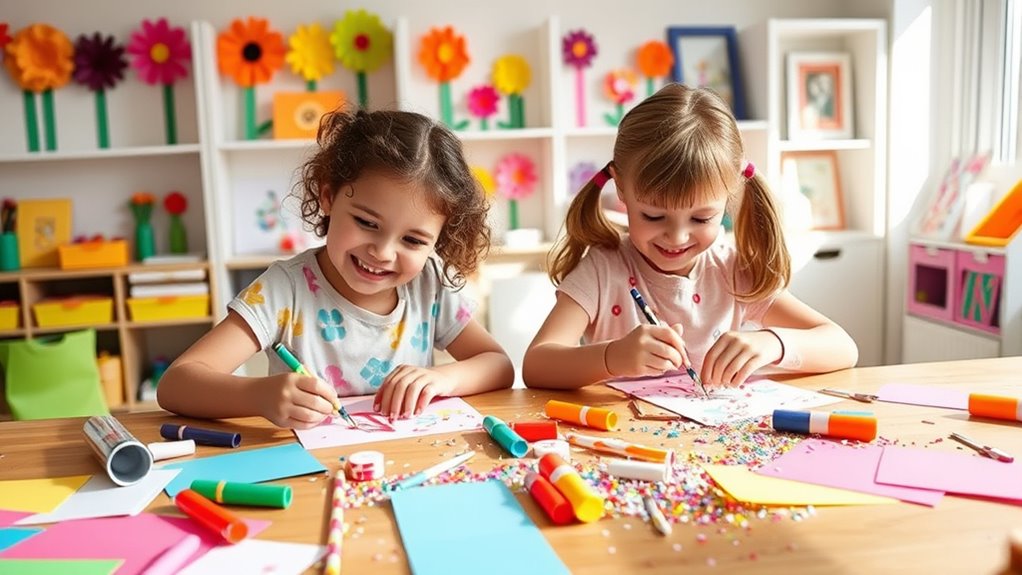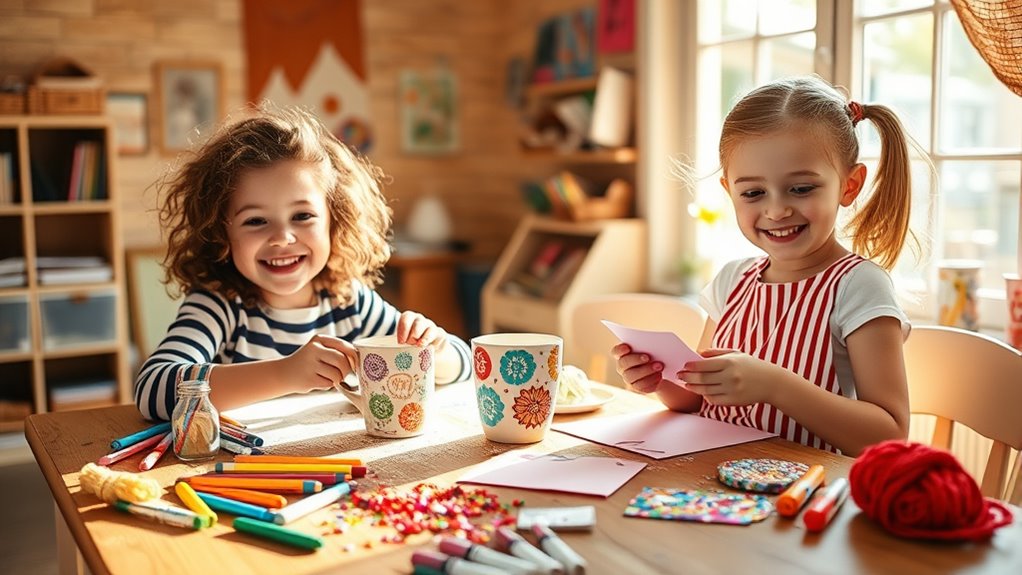Encouraging kids to create handmade gifts sparks their creativity and teaches valuable lessons about effort and thoughtfulness. Get them involved in planning, choosing materials, and making personalized presents, which boosts their confidence and pride. Enhance the experience with creative packaging using recycled materials and personal touches. By making the process fun and meaningful, you help your kids develop important skills while creating heartfelt surprises. Keep exploring for more ideas to make gift-giving truly special.
Key Takeaways
- Involve children in brainstorming and choosing materials to foster ownership and enthusiasm for their projects.
- Demonstrate fun, simple craft techniques to build confidence and inspire creativity in gift-making.
- Emphasize the importance of effort and thoughtfulness to motivate kids to create meaningful, personalized gifts.
- Incorporate themes or characters they love to make the crafting process engaging and relatable.
- Encourage eco-friendly practices like recycled wrapping to teach environmental responsibility and add a special touch.

Encouraging kids to create handmade gifts not only sparks their creativity but also teaches valuable lessons about effort and thoughtfulness. When you guide children in making DIY art projects, you’re helping them develop skills that go beyond the finished product. They learn to plan, execute, and take pride in their work, which boosts their confidence and sense of accomplishment. Plus, creating gifts by hand makes the giving experience more meaningful, as children understand the time and care involved.
Handmade gifts teach kids creativity, effort, and pride, making giving more meaningful and fun.
One way to enhance this experience is by showing kids fun and simple gift wrapping ideas. Wrapping their handmade items in creative ways adds an extra special touch, reinforcing the idea that presentation matters and that effort counts. You can use recycled materials like newspaper, fabric scraps, or brown paper bags to make wrapping eco-friendly and budget-friendly. Show them how to add personal touches—like hand-drawn tags, ribbons, or stamps—to turn plain wrapping into something unique. These small details teach kids that thoughtful presentation can elevate even the simplest gift, making the recipient feel truly appreciated.
Getting kids involved in DIY art projects for gifts encourages them to think outside the box. They can create personalized cards, painted ornaments, or decorated photo frames, all of which make heartfelt presents. As they experiment with different materials and techniques, they learn patience and problem-solving. This hands-on approach also nurtures their imagination, helping them see that gifts don’t have to be store-bought to be special. Instead, handmade items carry more emotional value because of the effort and love put into them.
You can make the process even more rewarding by involving children in every step—from brainstorming ideas to choosing materials and finalizing their projects. When kids see their ideas come to life, they develop a sense of ownership and pride. Encouraging them to think about the recipient’s interests ensures the gift feels personal and thoughtful. Additionally, understanding the significance of anime movies can inspire them to incorporate themes or characters they love into their creations, making the gifts even more meaningful. Plus, teaching them simple gift wrapping ideas makes the entire process more fun and engaging, turning it into a memorable activity for everyone involved.
Frequently Asked Questions
How Can I Motivate Shy Children to Start Making Gifts?
To motivate shy children to start making gifts, you should build their confidence by praising their efforts and making the activity fun. Encourage social sharing by creating a safe space where they can show their creations without judgment. Offer simple projects, and celebrate their progress. By focusing on positive reinforcement and gentle encouragement, you help shy kids feel more comfortable expressing themselves and sharing their handmade gifts with others.
What Safety Tips Should I Teach Kids During Craft Projects?
You should teach kids about craft safety by emphasizing the importance of tool supervision and handling supplies carefully. Show them how to use scissors, glue guns, and other tools properly, and always supervise their activities to prevent accidents. Encourage them to ask for help if they’re unsure. Reminding them to keep their workspace tidy and to wear protective gear when necessary will keep everyone safe and make crafting enjoyable.
How Do I Handle Messes and Cleanup After Crafting?
Think of cleanup as a gentle tide washing away chaos after a creative wave. You handle messes by establishing simple cleaning routines, like wiping surfaces and collecting supplies in bins. Encourage your kids to organize their craft supplies regularly, turning cleanup into a fun part of the process. This rhythm keeps the workspace tidy and teaches responsibility, making future projects smoother and more enjoyable for everyone involved.
What Age Is Appropriate for Kids to Make Handmade Gifts Alone?
You can start allowing kids as young as 4 to make handmade gifts alone, focusing on age-appropriate crafts that foster independence. At this age, they can handle simple tasks with supervision, building confidence and skills. As they grow, they can take on more complex projects. Always verify safety measures are in place, and choose activities that match their developmental stage to keep the experience fun and educational.
How Can I Inspire Kids to Personalize Their Handmade Gifts Creatively?
You can inspire kids to personalize their handmade gifts creatively by introducing fun crafting themes like nature, superheroes, or favorite colors. Encourage them to add unique touches such as drawings, stickers, or handwritten notes. Teach them about thoughtful gift presentation—wrapping with colorful paper, tying ribbons, or including a heartfelt message. This boosts their creativity and makes their gifts feel special, memorable, and truly personal.
Conclusion
Remember, “the best gifts come from the heart.” When you encourage your kids to create handmade presents, you’re teaching them valuable skills and fostering their creativity. These gifts carry more meaning and show genuine care. Plus, they’ll cherish the effort and love put into each one. So, get creative together and watch your child’s confidence and kindness grow—because, after all, the simplest gestures often mean the most.









